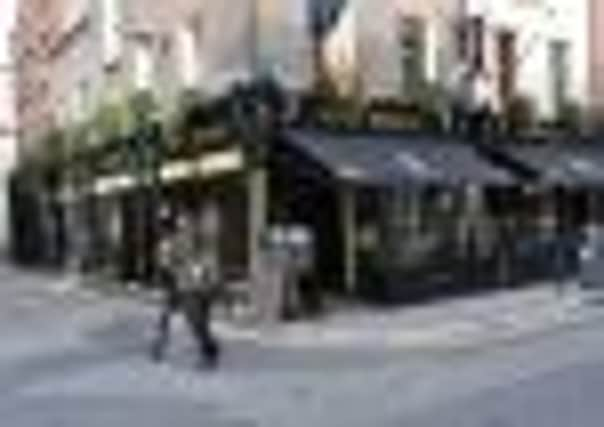Travel: Dublin, Ireland


THERE are only two places in the world where St Patrick’s Day, which takes place tomorrow, is an official public holiday: Ireland and, unlikely as it may seem, the Caribbean island of Montserrat – the latter being the site of a failed rebellion which Irish slaves fought against their colonial masters on 17 March 1768. I don’t know how Montserratians mark the day but, in Dublin, the country’s patron saint is celebrated with Mass, a parade and, of course, visiting several bars. The bar hopping has come to be known as drowning the shamrock after the custom of dropping your St Pat’s Day shamrock lapel badge into the last drink of the night.
It is not that drinking is the main point of St Patrick’s Day in Dublin but it is integral to the event.
Advertisement
Hide AdAs our host, John Quinn, the brand ambassador for Tullamore Dew whiskey, put it, “It is a family day where all the family gets together... and we all go to the pub”. Happily there is no shortage of fantastic pubs in Dublin. Numbers have dropped a bit since James Joyce’s time when the novelist’s city boasted some 4,000 bars but, today, with numbers hovering around 850 there are still plenty to go around.
Starting off in The Duke, a Victorian bar hung with pictures of Sean O’Casey, Samuel Beckett and George Bernard Shaw, The Dublin Literary Pub Crawl makes for a great introduction to the city’s bar scene. A potent mix of drink and erudition, it features local actors guiding visitors around some notable bars while performing scenes from Waiting for Godot; singing street ballads and lifting the lid on some of Oscar Wilde’s more vibrant experiences.
Each pub visited is coloured in with tales of the writers and poets who drank there along with the occasional nugget of pub architectural history. According to our guide, traditional Irish pubs such as the warren-like MJ O’Neill’s on Suffolk Street have snug bars so that women could drink in pubs without being seen by men and thus corrupting the otherwise upstanding men of Ireland. This prompted the writer and professional boozer Brendan Behan to quip that the Church had nothing to fear as Ireland was the only country where a man would crawl over ten naked women to get to a drink.
Certainly the longevity of many a Dublin pub suggests that the residents are keen to support the licensed trade. The Old Stand, on Exchequer Street, dates back more than 300 years although the decor is Victorian and features a carved wooden gantry hung with horse brasses. The Doran family who run the place have been in the Dublin pub trade for more than a hundred years. They also own the Davy Burns, the Duke Street bar immortalised in Joyce’s Ulysses as Leopold Bloom’s chosen hangout.
While many of Dublin’s pubs have retained their old-school charm, their food menus are often at the forefront of gastronomic fashion. WJ Kavanagh’s on Dorset Street is a case in point. Local products such as Arun Bakery bread; Glebe Brethen cheese from Louth and Bay Lough cauliflower are mixed and matched with more exotic touches such as wasabi mushy peas, smoked sea salt and black pudding wontons. The end result is a menu that gives a taste of Ireland but goes beyond the staples of stew, boxty and coddles. It helps that each dish is matched with a recommended craft ale.
While Dublin and Ireland have still not recovered from the financial crash, one part of the Celtic tiger is in fine fettle. It feels slightly heretical to be writing this in The Scotsman but Irish whiskey is booming and Tullamore Dew in particular is winning converts at a rate of knots. Owned by William Grant and Sons, who also have Glenfiddich, Tullamore Dew is regaining ground that was lost to 20th-century events such as Prohibition and the two world wars.
Advertisement
Hide AdLast year, the brand opened its newly renovated visitor centre in Tullamore, County Offaly, around 60 or so miles from Dublin. The centre tells the story of how the whiskey is triple distilled and, uniquely, made from grain, malt and pot still whiskies. It also relates how Daniel E Williams built the brand in the 19th century. Along the way, he brought both electricity and telephony to Tullamore as well as giving his initials to the whiskey.
A visit to the centre, complete with tutored tasting at the end of the tour, is a good way to appreciate the differences between Scotch and Irish whiskey. Not one imagines, that much of the former will be drunk in Dublin tomorrow. Instead, it will be Mr Williams’ whiskey being raised in glasses all over Dublin as the city celebrates Ireland’s patron saint.
THE FACTS
Advertisement
Hide AdAer Lingus (www.aerlin gus.com) and Ryanair (www.ryanair.com) both fly to Dublin from £40 one way. Rooms at The Dylan from E179, tel: +353 1 6603000, www.dylan.ie; www.dublinpubcrawl.com; www.tullamoredewvisitorcentre.com